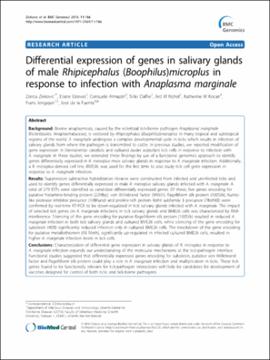| dc.contributor.author | Zivkovic, Zorica | |
| dc.contributor.author | Esteves, Eliane | |
| dc.contributor.author | Almazan, Consuelo | |
| dc.contributor.author | Daffre, Sirlei | |
| dc.contributor.author | Nijhof, Ard M. | |
| dc.contributor.author | Kocan, Katherine M. | |
| dc.contributor.author | Jongejan, Frans | |
| dc.contributor.author | de la Fuente, Jose | |
| dc.date.accessioned | 2018-11-09T21:11:03Z | |
| dc.date.available | 2018-11-09T21:11:03Z | |
| dc.date.issued | 2010-03-18 | |
| dc.identifier | oksd_zivkovic_differentialexp_2010 | |
| dc.identifier.citation | Zivkovic, Z., Esteves, E., Almazan, C., Daffre, S., Nijhof, A. M., Kocan, K. M., ... de la Fuente, J. (2010). Differential expression of genes in salivary glands of male Rhipicephalus (Boophilus) microplus in response to infection with Anaplasma marginale. BMC Genomics, 11, Article 186. https://doi.org/10.1186/1471-2164-11-186 | |
| dc.identifier.uri | https://hdl.handle.net/11244/302086 | |
| dc.description.abstract | Background: Bovine anaplasmosis, caused by the rickettsial tick-borne pathogen Anaplasma marginale (Rickettsiales: Anaplasmataceae), is vectored by Rhipicephalus (Boophilus)microplus in many tropical and subtropical regions of the world. A. marginale undergoes a complex developmental cycle in ticks which results in infection of salivary glands from where the pathogen is transmitted to cattle. In previous studies, we reported modification of gene expression in Dermacentor variabilis and cultured Ixodes scapularis tick cells in response to infection with A. marginale. In these studies, we extended these findings by use of a functional genomics approach to identify genes differentially expressed in R. microplus male salivary glands in response to A. marginale infection. Additionally, a R. microplus-derived cell line, BME26, was used for the first time to also study tick cell gene expression in response to A. marginale infection. | |
| dc.description.abstract | Results: Suppression subtractive hybridization libraries were constructed from infected and uninfected ticks and used to identify genes differentially expressed in male R. microplus salivary glands infected with A. marginale. A total of 279 ESTs were identified as candidate differentially expressed genes. Of these, five genes encoding for putative histamine-binding protein (22Hbp), von Willebrand factor (94Will), flagelliform silk protein (100Silk), Kunitz-like protease inhibitor precursor (108Kunz) and proline-rich protein BstNI subfamily 3 precursor (7BstNI3) were confirmed by real-time RT-PCR to be down-regulated in tick salivary glands infected with A. marginale. The impact of selected tick genes on A. marginale infections in tick salivary glands and BME26 cells was characterized by RNA interference. Silencing of the gene encoding for putative flagelliform silk protein (100Silk) resulted in reduced A. marginale infection in both tick salivary glands and cultured BME26 cells, while silencing of the gene encoding for subolesin (4D8) significantly reduced infection only in cultured BME26 cells. The knockdown of the gene encoding for putative metallothionein (93 Meth), significantly up-regulated in infected cultured BME26 cells, resulted in higher A. marginale infection levels in tick cells. | |
| dc.description.abstract | Conclusions: Characterization of differential gene expression in salivary glands of R. microplus in response to A. marginale infection expands our understanding of the molecular mechanisms at the tick-pathogen interface. Functional studies suggested that differentially expressed genes encoding for subolesin, putative von Willebrand factor and flagelliform silk protein could play a role in A. marginale infection and multiplication in ticks. These tick genes found to be functionally relevant for tick-pathogen interactions will likely be candidates for development of vaccines designed for control of both ticks and tick-borne pathogens. | |
| dc.format | application/pdf | |
| dc.language | en_US | |
| dc.publisher | BioMed Central | |
| dc.rights | This material has been previously published. In the Oklahoma State University Library's institutional repository this version is made available through the open access principles and the terms of agreement/consent between the author(s) and the publisher. The permission policy on the use, reproduction or distribution of the material falls under fair use for educational, scholarship, and research purposes. Contact Digital Resources and Discovery Services at lib-dls@okstate.edu or 405-744-9161 for further information. | |
| dc.title | Differential expression of genes in salivary glands of male Rhipicephalus (Boophilus) microplus in response to infection with Anaplasma marginale | |
| osu.filename | oksd_zivkovic_differentialexp_2010.pdf | |
| dc.description.peerreview | Peer reviewed | |
| dc.identifier.doi | 10.1186/1471-2164-11-186 | |
| dc.description.department | Veterinary Pathobiology | |
| dc.type.genre | Article | |
| dc.type.material | Text | |
| dc.subject.keywords | salivary gland | |
| dc.subject.keywords | suppression subtractive hybridization | |
| dc.subject.keywords | suppression subtractive hybridization library | |
| dc.subject.keywords | tick cell | |
| dc.subject.keywords | tick feeding | |
